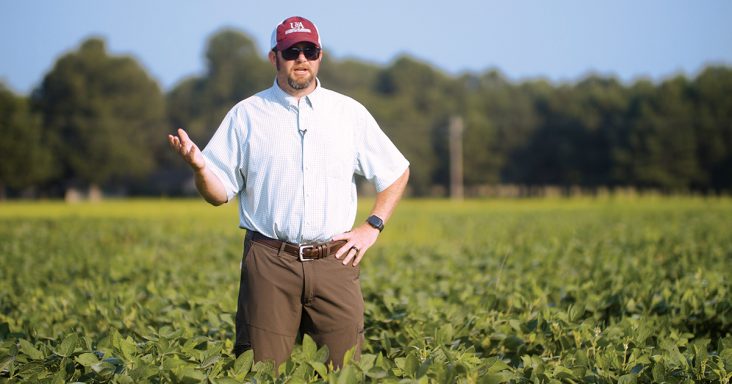Research finds positive cover crop impacts to soybean yields
by December 15, 2021 7:21 pm 455 views

Trent Roberts, soil specialist for the Cooperative Extension Service.
Arkansas is one of the top soybean producing states and new research may have found a method for improving crop yields. A three-year study conducted by the Arkansas Agricultural Experiment Station shows that cover crops can improve yields in soybean fields. The study also answers a lingering question about wheat-double-crop systems.
The cost of a cover crop system is comparable to a traditional system with tilling and no cover crop because tilling is taken out of the equation, according to Trent Roberts, associate professor of soil fertility and testing for the experiment station and a soil specialist for the Cooperative Extension Service.
“When we implement cover crops, we can only truly realize their full benefit to the production system when we also implement no-till practices at the same time,” Roberts said.
No-till saves about $30 to $60 per acre in labor and fuel expenses associated with tillage, depending on the equipment and number of passes used, he explained.
“That’s a very significant cost that will oftentimes more than pay for cover crop seed, planting and at least a part of the termination cost,” Roberts said.
The study compared soybeans that were grown in fields that had been fallow against those grown after wheat for grain in a double-crop system, and those grown after an assortment of cover crops including cereal rye, black-seeded oats, barley and Austrian winter pea. Researchers also used a 50/50 blend of Austrian winter pea and a “soybean blend” that contained cereal rye, turnip and crimson clover.
The fields with the greatest soybean yields were those grown after the no-till, chemically terminated cover crop, with a three-year average of about 63 bushels per acre. The best cover crop for soybeans was the 50/50 blend with Austrian winter pea and a “soybean blend,” Roberts noted.
The fallow fields produced about 10.5% fewer soybeans with a three-year average of approximately 57 bushels per acre.
Arkansas soybean acreage increased by more than 10% in 2021, growing from about 2.8 million acres in 2020 to about 3.1 million acres, with a forecast harvest of more than 3 million acres. Peanut acreage continued its steady growth in Arkansas, increasing from 39,000 acres in 2020 to 40,000 acres in 2021.
Roberts noted he often gets questions from producers about the profitability of the wheat-double-crop system. Knowing there is a strong relationship between planting date and yield potential in soybeans, producers have wondered how much yield is lost in Arkansas by waiting for the wheat harvest before planting soybeans, he said.
The study showed that soybeans grown right after a wheat crop produced on average 53 bushels per acre due to the later planting. However, the revenue from the wheat crop could make up for the loss in soybean yield, even with the added inputs, Roberts said.
There were “no statistical differences” in the economic returns of the double-crop system compared to some of the higher-yielding cover crop systems, Roberts said.
The highest returns were seen from most of the cover crop treatments, he added, but they were also very high in the double-crop wheat systems.
An average of soybean and wheat crop values over the past 10 years was used in the economic return analysis to capture potential fluctuations in commodity values over time.
In the no-till cover crop treatment, researchers measured numerical increases in both soil health and soil organic matter, though Roberts said the increases are not statistically significant. Nevertheless, soybean yields are improved in those no-till fields with cover crops.
Roberts explained that in many cases they see “the cumulative effects of increased infiltration, added weed control, increased water retention and reductions in evapotranspiration” where they have cover crops.
Although they are not seeing a statistically significant increase in soil health yet, Roberts said he and other researchers believe that continued implementation of cover crop practices will show significant increases or changes in soil health metrics over time.
For those who are new to cover crops, starting out with a system that incorporates soybeans as the cash crop is a good way to start, Roberts said.
“They’re very forgiving because of high seeding rates, and ability to do drilling or plant those high plant populations,” Roberts said. “It gives more flexibility if you do have stand issues.”
Farmers should experiment with what works best on their farm for soybean establishment into cover crops, but planters or drills set up for no-till planting will work best, he added.
“We have used a wide range of planters and drills to establish soybean into both green and terminated cover crops, and you can be successful if you take the time to get the equipment set properly and check at different spots in the field to ensure the seed furrow is properly closing,” Roberts said. “That is the struggle planting cover crops in no-till cover crop systems — getting the seed covered and the seed trench closed.”
The U.S. Department of Agriculture’s Natural Resource Conservation Service has funding available to start a cover crop program. The funding, which helps pay for seed and termination costs, can usually help a farmer get started with cover crops on about 300-350 acres.
The Arkansas cover crop study was conducted at three locations to measure the reaction to different environments and soils. Those locations were at the Pine Tree Research Station near Colt in St. Francis County; the Vegetable Research Station near Kibler in Crawford County; and the Rohwer Research Station in Desha County.
